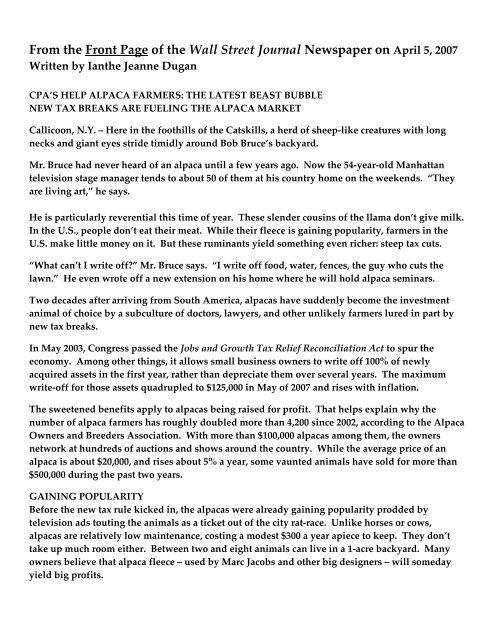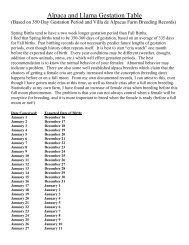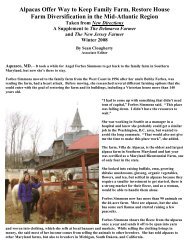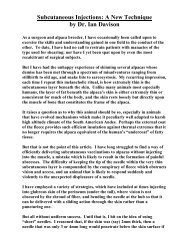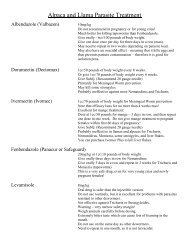cpa's help alpaca farmers: the latest beast bubble - Maryland Alpaca ...
cpa's help alpaca farmers: the latest beast bubble - Maryland Alpaca ...
cpa's help alpaca farmers: the latest beast bubble - Maryland Alpaca ...
- No tags were found...
Create successful ePaper yourself
Turn your PDF publications into a flip-book with our unique Google optimized e-Paper software.
From <strong>the</strong> Front Page of <strong>the</strong> Wall Street Journal Newspaper on April 5, 2007<br />
Written by Ian<strong>the</strong> Jeanne Dugan<br />
CPA’S HELP ALPACA FARMERS: THE LATEST BEAST BUBBLE<br />
NEW TAX BREAKS ARE FUELING THE ALPACA MARKET<br />
Callicoon, N.Y. – Here in <strong>the</strong> foothills of <strong>the</strong> Catskills, a herd of sheep‐like creatures with long<br />
necks and giant eyes stride timidly around Bob Bruce’s backyard.<br />
Mr. Bruce had never heard of an <strong>alpaca</strong> until a few years ago. Now <strong>the</strong> 54‐year‐old Manhattan<br />
television stage manager tends to about 50 of <strong>the</strong>m at his country home on <strong>the</strong> weekends. “They<br />
are living art,” he says.<br />
He is particularly reverential this time of year. These slender cousins of <strong>the</strong> llama don’t give milk.<br />
In <strong>the</strong> U.S., people don’t eat <strong>the</strong>ir meat. While <strong>the</strong>ir fleece is gaining popularity, <strong>farmers</strong> in <strong>the</strong><br />
U.S. make little money on it. But <strong>the</strong>se ruminants yield something even richer: steep tax cuts.<br />
“What can’t I write off” Mr. Bruce says. “I write off food, water, fences, <strong>the</strong> guy who cuts <strong>the</strong><br />
lawn.” He even wrote off a new extension on his home where he will hold <strong>alpaca</strong> seminars.<br />
Two decades after arriving from South America, <strong>alpaca</strong>s have suddenly become <strong>the</strong> investment<br />
animal of choice by a subculture of doctors, lawyers, and o<strong>the</strong>r unlikely <strong>farmers</strong> lured in part by<br />
new tax breaks.<br />
In May 2003, Congress passed <strong>the</strong> Jobs and Growth Tax Relief Reconciliation Act to spur <strong>the</strong><br />
economy. Among o<strong>the</strong>r things, it allows small business owners to write off 100% of newly<br />
acquired assets in <strong>the</strong> first year, ra<strong>the</strong>r than depreciate <strong>the</strong>m over several years. The maximum<br />
write‐off for those assets quadrupled to $125,000 in May of 2007 and rises with inflation.<br />
The sweetened benefits apply to <strong>alpaca</strong>s being raised for profit. That <strong>help</strong>s explain why <strong>the</strong><br />
number of <strong>alpaca</strong> <strong>farmers</strong> has roughly doubled more than 4,200 since 2002, according to <strong>the</strong> <strong>Alpaca</strong><br />
Owners and Breeders Association. With more than $100,000 <strong>alpaca</strong>s among <strong>the</strong>m, <strong>the</strong> owners<br />
network at hundreds of auctions and shows around <strong>the</strong> country. While <strong>the</strong> average price of an<br />
<strong>alpaca</strong> is about $20,000, and rises about 5% a year, some vaunted animals have sold for more than<br />
$500,000 during <strong>the</strong> past two years.<br />
GAINING POPULARITY<br />
Before <strong>the</strong> new tax rule kicked in, <strong>the</strong> <strong>alpaca</strong>s were already gaining popularity prodded by<br />
television ads touting <strong>the</strong> animals as a ticket out of <strong>the</strong> city rat‐race. Unlike horses or cows,<br />
<strong>alpaca</strong>s are relatively low maintenance, costing a modest $300 a year apiece to keep. They don’t<br />
take up much room ei<strong>the</strong>r. Between two and eight animals can live in a 1‐acre backyard. Many<br />
owners believe that <strong>alpaca</strong> fleece – used by Marc Jacobs and o<strong>the</strong>r big designers – will someday<br />
yield big profits.
The tax change kicked <strong>the</strong> trend into high gear. Several experts are spreading <strong>alpaca</strong> tax advice in<br />
books and online. “Tax law is certainly working to keep <strong>the</strong> <strong>alpaca</strong> industry growing!” according<br />
to an online article by Susan Post, an Iowa accountant who says she relies on <strong>alpaca</strong> <strong>farmers</strong> for<br />
20% of her business. A free download of her book, “The Tax Impact of Investing in <strong>Alpaca</strong>s,” is<br />
available online.<br />
Among <strong>the</strong> new <strong>alpaca</strong> <strong>farmers</strong> is Gregory Myers, 44, a software engineer in Camas, Washington.<br />
During <strong>the</strong> Internet boom, he was creamed by taxes on stock options he received working for an<br />
Internet company, WebTrends Inc. He says <strong>the</strong> <strong>alpaca</strong>s now roaming his 5‐acre yard not only cut<br />
his income tax but his property taxes as well, since he now calls his home a farm.<br />
“Had I bought stocks and bonds, I would not have been able to write that off as expenditures,”<br />
says Mr. Myers.<br />
ALPACA PROPONENTS SAY THEY HAVE LEARNED FROM PREVIOUS BUSTS<br />
Critics worry that <strong>alpaca</strong> fever will end badly, joining in o<strong>the</strong>r speculative <strong>bubble</strong>s in agriculture.<br />
Prices of llamas – used for trekking and guarding farm animals – collapsed in <strong>the</strong> early 1990’s<br />
because too many were imported. (Yet today, some suri llamas can fetch prices equal to or higher<br />
than <strong>the</strong> regular <strong>alpaca</strong> market! The importation of <strong>alpaca</strong>s from South America to <strong>the</strong> U.S. closed<br />
in 1999.) Ostrich mania melted when <strong>the</strong> meat failed to penetrate mainstream palates. (It is<br />
important to realize that emus/ostriches can produce many, many eggs and thus produce lots of<br />
offspring every week which flooded <strong>the</strong>ir market; on <strong>the</strong> o<strong>the</strong>r hand, an <strong>alpaca</strong> has a year long<br />
gestation and only can produce one offspring per year maximum.)<br />
About 4,000 tons of <strong>alpaca</strong> fiber is produced world‐wide every year. Much comes from Peru,<br />
which has three million <strong>alpaca</strong>s and inexpensive labor. U.S. owners, unable to compete with that<br />
market, only make real money by selling <strong>the</strong> animals.<br />
Mr. Myers built a mill for $60,000, hoping to process enough fiber to fund his farm. But <strong>the</strong> mill<br />
went bust, sending Mr. Myers back to work at a software company to pay off <strong>the</strong> debt. “<strong>Alpaca</strong><br />
fleece was not as profitable as I thought it would be,” he sighs.<br />
“It’s a classic pyramid scheme,” scoffs Richard Sexton, a professor of agricultural economics at <strong>the</strong><br />
University of California, Davis, who co‐authored a study entitled “<strong>Alpaca</strong> Lies.” <strong>Alpaca</strong>s, he says,<br />
shouldn’t sell for more than a few hundred dollars.<br />
Tell that to Jim Webb. The 56‐year‐old Virginia home builder last year plunked down $750,000 on<br />
just half an <strong>alpaca</strong> named Legacy. “I may be <strong>the</strong> biggest idiot walking <strong>the</strong> face of <strong>the</strong> earth, or I<br />
may be enhancing blood‐lines and increasing my own income”, says Mr. Webb.<br />
<strong>Alpaca</strong> proponents say that <strong>the</strong>y have learned from previous busts and vow to protect <strong>the</strong> <strong>alpaca</strong><br />
market. The industry’s official registry a few years ago stopped including <strong>alpaca</strong>s born outside<br />
<strong>the</strong> U.S., deterring imports. Registry officials say <strong>the</strong>y are improving U.S. fiber. Mr. Sexton calls it<br />
a “futile attempt at protectionism”.<br />
A CINDERELLA STORY
<strong>Alpaca</strong>s first came in <strong>the</strong> U.S. in 1984 from Chile when <strong>the</strong> U.S. lifted a ban. “For years, <strong>the</strong>y were<br />
<strong>the</strong> forgotten stepchildren of llamas”, says Bill Coburn, an Ohio farmer who imported a few that<br />
year. “It is a Cinderella story, really.”<br />
Many more arrived after barriers with Peru were removed in 1994. Mr. Coburn purchased an<br />
<strong>alpaca</strong> named Royal Fawn from <strong>the</strong> <strong>alpaca</strong> world’s folk hero – Don Julio Berreda. With its fine<br />
fleece, Royal Fawn earned about $3 million in stud fees, siring some 500 babies, known as cria, Mr.<br />
Cobrun says. In late 2005, a Virginia electrical engineer named Ernest Kellogg bought Royal Fawn<br />
with ano<strong>the</strong>r investor for $600,000.<br />
By <strong>the</strong>n, <strong>the</strong> new tax rules had kicked in. “I had never stepped foot on a farm before, says Brion<br />
Smoker, a 55‐year‐old accountant, near Hershey, PA. Last year, he bought <strong>alpaca</strong>s with a $110,000<br />
low cost loan backed by a Pennsylvania economic‐development program. He says he has cut his<br />
taxable income by more than $40,000! The write‐off cannot exceed taxable income. The new law is<br />
set to expire at <strong>the</strong> end of 2009.


